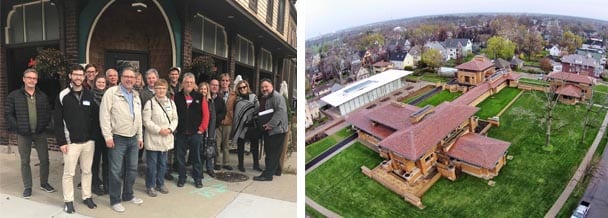 In 2017, the Frank Lloyd Wright (FLW) Trust marks the 150th anniversary of the legendary architect’s birth, so a recent tour of a complex designed by Wright held even more significance for members of the IDSA Central New York Chapter. In 1903, Wright was told by entrepreneur Darwin Martin that if Wright could successfully design a house for Martin in Buffalo, then Wright could design Martin’s soap company headquarters. Wright ended up designing both.
In 2017, the Frank Lloyd Wright (FLW) Trust marks the 150th anniversary of the legendary architect’s birth, so a recent tour of a complex designed by Wright held even more significance for members of the IDSA Central New York Chapter. In 1903, Wright was told by entrepreneur Darwin Martin that if Wright could successfully design a house for Martin in Buffalo, then Wright could design Martin’s soap company headquarters. Wright ended up designing both.
The Martin House “serves as a bold expression of Wright’s powerful vision for a new American architecture,” says the FLW Trust, which adds that the house is considered by leading Wright scholars as one of his “finest achievements of the Prairie period and, indeed, of his entire career.” The complex contains nearly 400 pieces of art glass, including the famed “Tree of Life” window, designed by Wright himself.
The approximately 50,000 sq. ft. complex—which has been on the National Register of Historic Places since 1975—has been undergoing renovations since 1996 that are expected eventually to cost $50 million. The complex includes a pergola, conservatory, another house, carriage house/stable and gardener’s cottage. It also features the Greatbatch Pavilion, a welcome and interpretive center designed by Toshiko Mori Architects. “The Visitor Center is a design showpiece in its own right,” says Greg Smiley, IDSA, chair of IDSA CNY.
“The Martin complex was spectacular! It was a great, two-hour tour,” raves Karl Kober, a longtime IDSA member. “What struck me the most was the extreme attention to detail. Every aspect was thought out—and custom designed and built. Entryways, stained glass windows, HVAC piping, furniture, flooring, cabinets—even the views! you’re a designer and visit Buffalo, you have to take this tour!”
Kober’s design studio KEK provided round-trip bus transportation to the tour, and lunch at Parkside Meadow. “It was very good from a camaraderie standpoint; we were able to mingle and chat. We had an FLW trivia contest on the way and even worked on FLW Lego kits!” Wright had industrial design leanings. In addition to designing windows, he also designed furniture. “Wright was one of the first architect/designer ‘rock stars’ and I’m sure that fueled a generation of designers who saw ID as a viable, attractive and productive discipline,” says Kober.
And in the article “Rediscovering Wright, the Product Designer” in Metropolis magazine, Audrey Gray reports 46 companies around the world hold licenses to develop products—from textiles and paints, to lamps and even acoustic panels—using Wright’s intellectual property such as photos, letters, sketches, paintings, models, books and flimsy. Cassina licenses Wright’s furniture concepts.